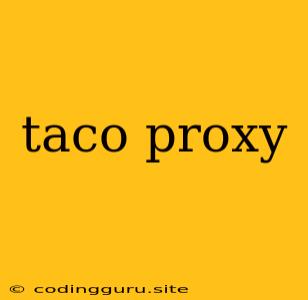What is Taco Proxy and Why You Should Care
In the realm of web development, the term "proxy" often evokes images of anonymity and security, but what about Taco Proxy? It might sound like a quirky name for a food delivery service, but in reality, it's a powerful tool used by developers to simplify and streamline the process of building and testing web applications.
Understanding the Basics: What is a Proxy?
Before delving into the specifics of Taco Proxy, let's first understand the core concept of a proxy. In essence, a proxy acts as an intermediary between your web browser or application and the actual server hosting the website or service you're trying to access. Think of it like a friendly postman who delivers your requests and receives responses on your behalf.
The Power of Taco Proxy: Why Should You Use It?
Taco Proxy brings a unique twist to traditional proxy functionality. It's designed to make your life easier by:
-
Mocking APIs: When you're developing an application, you often need to interact with APIs (Application Programming Interfaces) provided by external services. However, these APIs might not be fully functional or readily available during the initial stages of development. Taco Proxy allows you to create "mock" versions of these APIs, providing you with controlled data and responses, enabling you to build and test your application without relying on external dependencies.
-
Simplifying Testing: Imagine you're testing a feature that requires user authentication. Instead of going through the entire login process every time, you can use Taco Proxy to intercept and manipulate the authentication requests and responses, allowing you to quickly test different authentication scenarios without the hassle.
-
Debugging Web Traffic: Ever wondered how a website is sending data back and forth between your browser and the server? Taco Proxy allows you to intercept and analyze the raw HTTP traffic, giving you a clear understanding of how requests are made, what data is being exchanged, and how the server responds. This can be invaluable for debugging issues, understanding how a website works, and finding performance bottlenecks.
How Taco Proxy Works: A Behind-the-Scenes Look
Taco Proxy operates by intercepting web requests from your browser or application. It then applies a set of rules you define to modify these requests before forwarding them to the actual server. Similarly, it can also intercept and modify the server's responses before they reach your application.
Getting Started with Taco Proxy: A Practical Guide
-
Installation: Taco Proxy is typically available as a command-line tool or a browser extension. The installation process varies depending on your operating system and chosen installation method.
-
Configuration: After installation, you need to configure Taco Proxy with rules that dictate how it should modify requests and responses. These rules can be simple (like changing the URL of a request) or complex (like simulating a specific API response).
-
Running Taco Proxy: Once configured, start Taco Proxy. It will then begin intercepting and modifying your web traffic according to the rules you've defined.
Examples of Taco Proxy Use Cases
-
Mocking a Payment Gateway: While building an e-commerce application, you might need to integrate with a payment gateway like Stripe. Taco Proxy lets you create a mock version of the Stripe API, so you can test your payment processing logic without having to worry about real-world payment transactions during development.
-
Testing Different User Roles: When developing a web application with different user roles (like administrator, moderator, and regular user), you can use Taco Proxy to simulate different authentication scenarios. You can intercept authentication requests and modify the responses to represent various user roles, allowing you to test how your application behaves with each role.
-
Debugging Web APIs: If you're experiencing issues with a specific web API, you can use Taco Proxy to inspect the raw HTTP requests and responses, revealing valuable information about the nature of the problem and aiding in the debugging process.
Conclusion
Taco Proxy is a powerful tool for web developers. Its ability to mock APIs, simplify testing, and provide insights into web traffic makes it an essential asset for anyone involved in building, debugging, or analyzing web applications. Whether you're working on a personal project or collaborating with a team, Taco Proxy can streamline your workflow and significantly enhance your development process.
